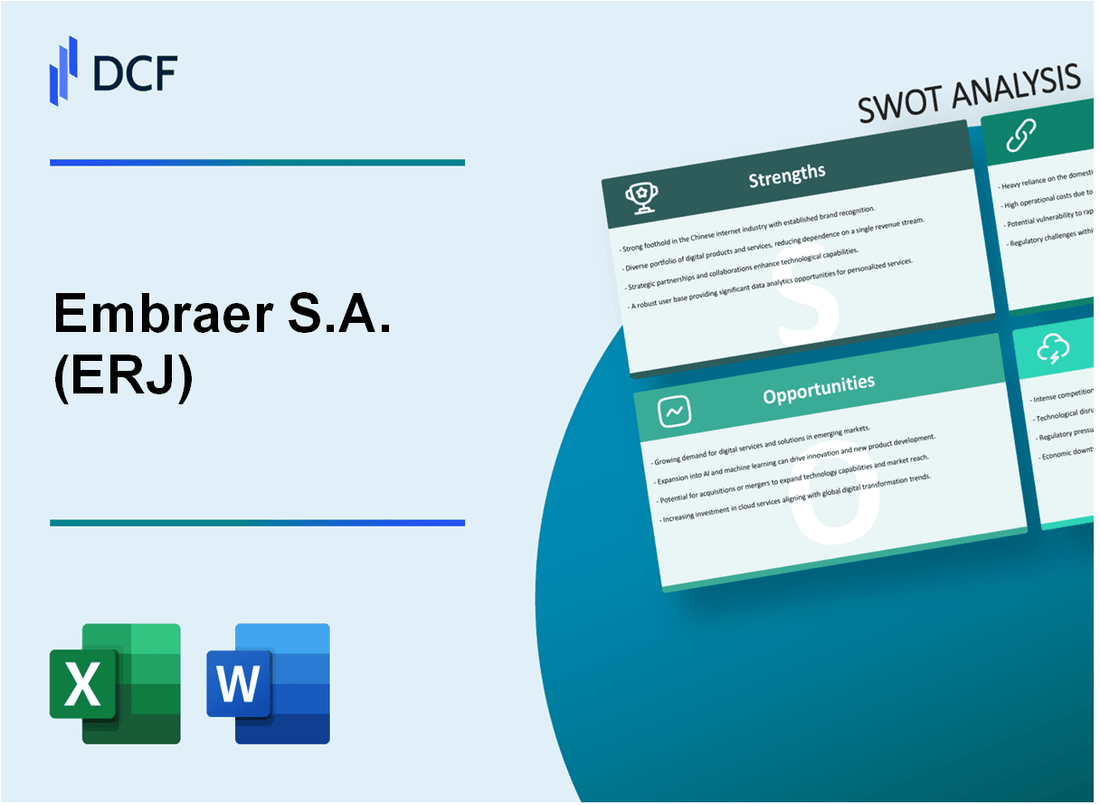
|
Embraer S.A. (ERJ): SWOT Analysis [Jan-2025 Updated] |

Fully Editable: Tailor To Your Needs In Excel Or Sheets
Professional Design: Trusted, Industry-Standard Templates
Investor-Approved Valuation Models
MAC/PC Compatible, Fully Unlocked
No Expertise Is Needed; Easy To Follow
Embraer S.A. (ERJ) Bundle
In the dynamic world of aerospace manufacturing, Embraer S.A. stands as a pivotal player navigating complex global markets with strategic precision. This comprehensive SWOT analysis reveals the Brazilian aerospace giant's intricate landscape of competitive advantages, challenges, and potential trajectories, offering unprecedented insights into how this innovative company positions itself for success in the 2024 business environment. From its robust technological capabilities to the nuanced challenges of international aerospace competition, Embraer's strategic positioning emerges as a fascinating study of resilience, innovation, and strategic maneuvering in one of the world's most sophisticated industrial sectors.
Embraer S.A. (ERJ) - SWOT Analysis: Strengths
Leading Global Manufacturer of Regional and Commercial Aircraft
Embraer ranked 3rd globally in commercial aircraft production as of 2023. The company produced 314 commercial and executive aircraft in 2022, generating $4.22 billion in commercial aviation revenue.
| Aircraft Category | Annual Production | Market Share |
|---|---|---|
| Regional Jets | 170 aircraft | 45% global market share |
| Executive Jets | 144 aircraft | 20% global market share |
Strong Reputation in Aerospace Engineering and Design
Embraer invested $335.7 million in research and development in 2022, representing 3.8% of total company revenue.
- Holds 1,600+ active patents
- Recognized with multiple aerospace engineering awards
- Consistently ranked in top 10 global aerospace engineering firms
Diversified Portfolio
Revenue breakdown for 2022:
| Segment | Revenue | Percentage |
|---|---|---|
| Commercial Aviation | $4.22 billion | 48% |
| Defense | $1.85 billion | 21% |
| Executive Aviation | $2.15 billion | 24% |
Significant Presence in Emerging Markets
Latin American market representation:
- 70% market share in regional aircraft
- Operating in 24 countries
- Primary aircraft supplier for 12 Latin American airlines
Advanced Technological Capabilities
Technology investments in 2022: $385.6 million, focusing on sustainable aviation technologies and next-generation aircraft design.
| Technology Area | Investment | Key Focus |
|---|---|---|
| Electric Propulsion | $125.3 million | Sustainable aircraft technologies |
| Digital Manufacturing | $92.4 million | Advanced production techniques |
| AI and Automation | $167.9 million | Smart manufacturing processes |
Embraer S.A. (ERJ) - SWOT Analysis: Weaknesses
High Dependency on Commercial Aviation Market's Cyclical Nature
Embraer's financial performance is significantly impacted by commercial aviation market volatility. In 2023, the company's commercial aviation segment revenue was $3.8 billion, representing 48% of total revenue.
| Market Segment | Revenue (2023) | Percentage of Total |
|---|---|---|
| Commercial Aviation | $3.8 billion | 48% |
| Defense & Security | $2.1 billion | 26% |
| Executive Aviation | $1.9 billion | 24% |
Substantial Debt Levels from Research and Development Investments
As of Q4 2023, Embraer's total debt stood at $4.6 billion, with annual R&D investments reaching $387 million.
Limited Market Share Compared to Larger Aerospace Competitors
- Global commercial aircraft market share: 3.5%
- Boeing market share: 39.7%
- Airbus market share: 42.3%
Vulnerability to Currency Exchange Rate Fluctuations
In 2023, Embraer experienced $126 million in currency exchange-related losses, representing 3.2% of total revenue.
Complex Global Supply Chain Management Challenges
| Supply Chain Metric | 2023 Data |
|---|---|
| Number of Global Suppliers | 1,200+ |
| International Procurement Locations | 12 countries |
| Supply Chain Management Costs | $412 million |
Embraer S.A. (ERJ) - SWOT Analysis: Opportunities
Growing Demand for Fuel-Efficient and Environmentally Friendly Regional Aircraft
The global regional aircraft market is projected to reach $56.24 billion by 2028, with a CAGR of 5.2%. Embraer's E-Jet E2 family offers 16-24% lower fuel consumption compared to previous generation aircraft.
| Aircraft Model | Fuel Efficiency Improvement | Estimated CO2 Reduction |
|---|---|---|
| E175-E2 | 16% lower fuel burn | 19.5% CO2 reduction |
| E190-E2 | 24% lower fuel burn | 22.3% CO2 reduction |
Potential Expansion in Defense and Military Aircraft Markets
Embraer's defense segment generated $1.4 billion in revenue in 2022, with significant potential for growth in military aircraft markets.
- Brazil's military modernization budget: $4.3 billion in 2023
- Projected global military aircraft market: $292.6 billion by 2030
- Embraer's key defense platforms: KC-390 Millennium transport aircraft
Increasing Commercial Aircraft Replacement Cycles in Developing Economies
Emerging markets are expected to acquire approximately 8,500 new regional aircraft by 2040, valued at $500 billion.
| Region | Projected Aircraft Acquisitions | Market Value |
|---|---|---|
| Latin America | 1,200 aircraft | $85 billion |
| Asia-Pacific | 3,600 aircraft | $240 billion |
Strategic Partnerships and Joint Ventures in Emerging Aerospace Markets
Embraer has established strategic partnerships with multiple global aerospace companies, including Boeing and China's Aviation Industry Corporation.
- China joint venture: $1.2 billion commercial aircraft partnership
- Boeing collaboration: Valued at $4.2 billion prior to termination
- Current global partnership investments: $750 million
Potential Growth in Urban Air Mobility and Electric Aircraft Technologies
Global urban air mobility market projected to reach $1.5 trillion by 2040, with electric aircraft technologies gaining significant traction.
| Technology | Market Projection | Expected Growth |
|---|---|---|
| Electric Regional Aircraft | $25 billion by 2035 | CAGR 22.7% |
| Urban Air Mobility | $1.5 trillion by 2040 | CAGR 15.3% |
Embraer S.A. (ERJ) - SWOT Analysis: Threats
Intense Global Competition in Aerospace Manufacturing
The global aerospace manufacturing market shows significant competitive pressures. Boeing and Airbus dominate 91.5% of the commercial aircraft market as of 2023. Embraer faces direct competition from Bombardier and Mitsubishi Heavy Industries in regional jet segments.
| Competitor | Market Share (%) | Annual Revenue (USD) |
|---|---|---|
| Boeing | 50.7 | 66.6 billion |
| Airbus | 40.8 | 54.3 billion |
| Embraer | 4.2 | 4.7 billion |
Potential Economic Downturns Affecting Airline Industry Investments
Global airline industry investment sensitivity remains high. International Air Transport Association (IATA) projected 2024 net profits at $9.8 billion, representing a narrow 1.2% margin.
- Global commercial aircraft order backlog: 16,500 units
- Projected aircraft investment decline: 3.7% in 2024
- Estimated fleet replacement costs: $1.7 trillion
Ongoing Geopolitical Tensions Disrupting International Trade
Current geopolitical tensions impact aerospace manufacturing supply chains. Trade restrictions between United States and China have created significant market uncertainties.
| Region | Trade Restriction Impact (%) | Supply Chain Disruption Cost |
|---|---|---|
| North America | 4.5 | $2.3 billion |
| Europe | 3.2 | $1.8 billion |
| Asia-Pacific | 5.7 | $3.6 billion |
Stringent Environmental Regulations Increasing Compliance Costs
International environmental regulations require significant investment in sustainable technologies. Estimated compliance costs for aerospace manufacturers range between 4-7% of annual revenue.
- Carbon emission reduction targets: 50% by 2050
- Sustainable aviation fuel investment: $15.3 billion annually
- Projected green technology development costs: $2.6 billion
Technological Disruptions from Emerging Aerospace Competitors
Emerging technological competitors introduce advanced manufacturing techniques and innovative design approaches. Investment in research and development remains critical for maintaining competitive positioning.
| Emerging Competitor | R&D Investment (USD) | Technological Focus |
|---|---|---|
| COMAC (China) | 1.2 billion | Regional Jet Development |
| UAC (Russia) | 0.9 billion | Military and Commercial Aircraft |
| Mitsubishi | 0.7 billion | Regional Jet Innovation |
Disclaimer
All information, articles, and product details provided on this website are for general informational and educational purposes only. We do not claim any ownership over, nor do we intend to infringe upon, any trademarks, copyrights, logos, brand names, or other intellectual property mentioned or depicted on this site. Such intellectual property remains the property of its respective owners, and any references here are made solely for identification or informational purposes, without implying any affiliation, endorsement, or partnership.
We make no representations or warranties, express or implied, regarding the accuracy, completeness, or suitability of any content or products presented. Nothing on this website should be construed as legal, tax, investment, financial, medical, or other professional advice. In addition, no part of this site—including articles or product references—constitutes a solicitation, recommendation, endorsement, advertisement, or offer to buy or sell any securities, franchises, or other financial instruments, particularly in jurisdictions where such activity would be unlawful.
All content is of a general nature and may not address the specific circumstances of any individual or entity. It is not a substitute for professional advice or services. Any actions you take based on the information provided here are strictly at your own risk. You accept full responsibility for any decisions or outcomes arising from your use of this website and agree to release us from any liability in connection with your use of, or reliance upon, the content or products found herein.
